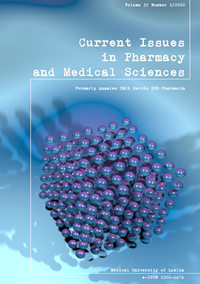Experimental study of the antiulcer effect of cryopreserved placenta extract on a model of acetylsalicylic acid-induced ulcerogenesis
DOI:
https://doi.org/10.2478/cipms-2022-0017Keywords:
cryopreserved placenta extract, nonsteroidal anti-inflammatory drugs, ulcerogenicityAbstract
Introduction. The gastrotoxicity of nonsteroidal anti-inflammatory drugs is a leading side effect that significantly limits their clinical use, among other types of their toxicity (nephrotoxicity, hepatotoxicity, cardiotoxicity, etc.). Cryopreserved placenta extract has drawn our attention as a potential modifier of the ulcerogenic action of nonsteroidal anti-inflammatory drugs.
Aim.To characterize the cytoprotective properties of cryopreserved placenta extract by the condition of the mucous membrane of the proximal (esophagus and stomach) and distal (small and large intestine) parts of the gastrointestinal (GI) tract on the model of ASA-induced ulcerogenesis.
Material and methods.The study was performed using 28 male rats weighing 200-220 g. Subchronic ASA-induced ulcerogenesis of the digestive tract was reproduced by intragastrically administration to rats of ASA in a dose of 150 mg/kg. The effect of the studied drugs on the condition of the mucous membrane of the digestive tract was assessed macroscopically by the following criteria: edema, redness and hemorrhage on the surface of the mucous membrane. The ulcer index for each group of animals was calculated.
Results and discussion.Five doses of ASA 150 mg/kg cause damage to the esophagus, stomach, small and large intestines in all of the rats. The use of the proton pump inhibitor esomeprazole has pronounced gastrocytoprotective properties, but does not affect the ulcerogenic effect in the small intestine, and in the colon, it enhances it. This is indicated by ulcerative lesions of the colon in 57.1% of all rats administered ASA and esomeprazole, as well as in the folding of the gastric mucosa. In contrast, mild hyperemia of the gastric mucosa was seen in 28.6% of all rats and moderate hemorrhage in 57.1% of all rats due to the combined use of ASA and cryoextract placenta.
Conclusions.The use of cryopreserved placenta extract is statistically significantly (p <0.05) inferior to the antiulcer activity of esomeprazole in the stomach. Thus, the ulcer index on the background of the use of ASA and cryopreserved placenta extract was 0.97, and on the background of the use of ASA and esomeprazole – 0.39. In the distal parts of the GI tract cryoextract placenta showed cytoprotective properties against the background of induced ASA ulcerogenesis, in contrast to esomeprazole.
References
1. Laidlaw TM, Cahill KN. Current knowledge and management of hypersensitivity to aspirin and NSAIDs. J Allergy Clin Immunol Pract. 2017;5(3):537-45.
2. Hladkykh F, Chyzh M. Modulation of meloxicam-induced changes in gastrointestinal and motor activity of the stomach by applying placenta cryoextract. Proc Shevchenko Sci Soc Med Sci. 2021;64(1):84-94.
3. Hladkykh FV, Chyzh MO, Manchenko AO, Belochkіna IV, Mikhailova IP. Effect of cryopreserved placenta extract on some biochemical indices of therapeutic efficiency and toxicity of diclofenac sodium in adjuvant-induced experimental arthritis. Pharm Pharmacol. 2021;9(4):278-93.
4. Drini M. Peptic ulcer disease and non-steroidal anti-inflammatory drugs. Aust Prescr. 2017;40(3):91-3.
5. Xie W, Huang X, Chen R, Chen R, Li T, Wu W, et al. Esomeprazole alleviates the damage to stress ulcer in rats through not only its antisecretory effect but its antioxidant effect by inactivating the p38 MAPK and NF-κB signaling pathways. Drug Des Devel Ther. 2019;22(13):2969-84.
6. Satoh H, Akiba Y, Urushidani T. Proton pump inhibitors prevent gastric antral ulcers induced by NSAIDs via activation of capsaicin sensitive afferent nerves in mice. Dig Dis Sci. 2020;65:2580-94.
7. Hladkykh FV. Characteristic of mechanisms of antiulcerogenic action of agents of vanilloid receptors (TRPV1) on the model of gastropathy induced by acetylsalicylic acid. Pharm Pharmacol. 2017;5(3):283-301.
8. Hladkykh FV. The effect of meloxicam and cryopreserved placenta extract on initial inflammatory response – an experimental study. Ceska Slov Farm. 2021;70(5):181-7.
9. Hong JW, Lee WJ, Hahn SB, Kim BJ, Lew DH. The effect of human placenta extract in a wound healing model. Ann Plast Surg. 2010;65(1):96-100.
10. Wu SC, Pollak R, Frykberg RG, Zhou W, Karnoub M, Jankovic V, et al. Safety and efficacy of intramuscular human placenta-derived mesenchymal stromal-like cells (cenplacel [PDA-002]) in patients who have a diabetic foot ulcer with peripheral arterial disease. Int Wound J. 2017;14(5):823-9.
11. Francki A, Labazzo K, He S, Baum EZ, Abbot SE, Herzberg U, et al. Celgene Cellular Therapeutics Research Group. Angiogenic properties of human placenta-derived adherent cells and efficacy in hindlimb ischemia. J Vasc Surg. 2016;64(3):746-56.
12. Pan SY, Chan MKS, Wong MBF, Klokol D, Chernykh V. Placental therapy: An insight to their biological and therapeutic properties. JMT. 2017;1(3):1-6
13. Stefanov OV. Preclinical studies of drugs: guidelines. Kyiv: Avicenna; 2001:527.
14. Vogel HG. Drug discovery and evaluation: Pharmacological assays. Berlin, Heidelberg: Springer Berlin Heidelberg; 2008:2071.
15. Modlin IM, Hunt RH, Malfertheiner P, Moayyedi P, Quigley EM, Tytgat GN, et al. Diagnosis and management of non-erosive reflux disease – the Vevey NERD Consensus Group. Digestion. 2009;80(2):74-88.
16. Schneider NI, Plieschnegger W, Geppert M, Wigginghaus B, Hoess GM, Eherer A, et al. Validation study of the Esohisto consensus guidelines for the recognition of microscopic esophagitis. Hum Pathol. 2014;45(5):994-1002.
Downloads
Published
Issue
Section
License
Copyright (c) 2022 Author

This work is licensed under a Creative Commons Attribution-NonCommercial-NoDerivatives 3.0 Unported License.


